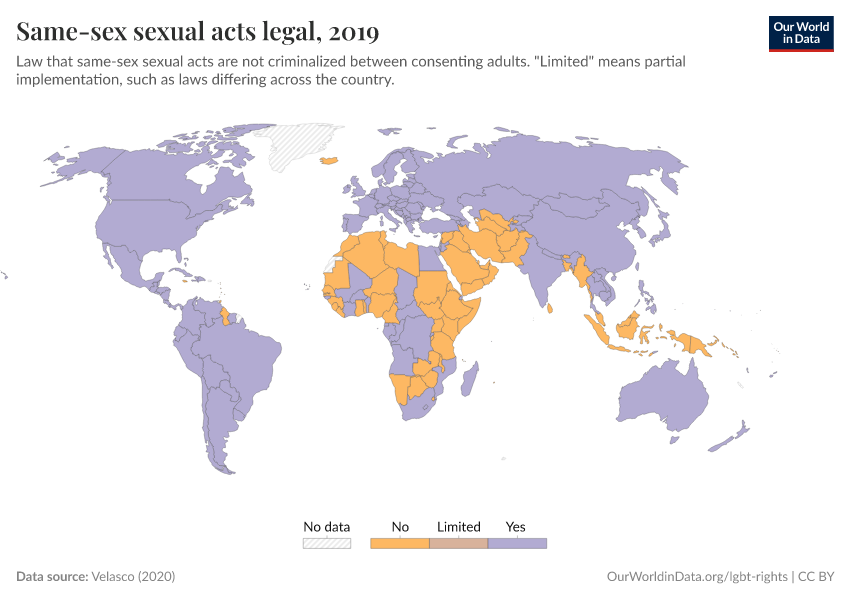Same-sex sexual acts legal

What you should know about this indicator
- This policy is not measured in a binary (adopted/not-adopted) scheme; the author follows Frank and colleagues (2010, 2017) in considering that similar policies can meaningfully vary in scope, benefits, punishment, etc. So, he determines the robustness of each policy by reviewing five indicators.
- These indicators are (between parentheses are the scoring schemes): Proportion of Population Living Under Law, to acknowledge subnational variations (0-1), Scope of Genders Subject to Law, as they can be typically differentiated by gender (0: no law, 0.5: just men or women, 1: both), Maximum Level of Punishment, for regressive policies (0: no law, 0.2: less than 3 years, 0.4: over 3 years and less than 15 years, 0.6: over 15 years and less than life in prison, 0.8: life in prison, 1: death penalty), Ease of Access, to benefits the law outlines (0: no law, 0.25: significant barriers, 0.5: moderate barriers, 0.75: little to few barriers, 1: no barriers, and Evidence of Enforcement that considers whether at least one case has happenedthe previous year where this was implemented (0: no evidence, 1: evidence).
- At least three different indicators are used to estimate the policy score, with the result that each policy score ranges from 0 to 1. Therefore, a score of 1 corresponds to that policy's most robust scope and implementation. This also means that changes in any indicator will influence each policy’s overall score.
What you should know about this indicator
- This policy is not measured in a binary (adopted/not-adopted) scheme; the author follows Frank and colleagues (2010, 2017) in considering that similar policies can meaningfully vary in scope, benefits, punishment, etc. So, he determines the robustness of each policy by reviewing five indicators.
- These indicators are (between parentheses are the scoring schemes): Proportion of Population Living Under Law, to acknowledge subnational variations (0-1), Scope of Genders Subject to Law, as they can be typically differentiated by gender (0: no law, 0.5: just men or women, 1: both), Maximum Level of Punishment, for regressive policies (0: no law, 0.2: less than 3 years, 0.4: over 3 years and less than 15 years, 0.6: over 15 years and less than life in prison, 0.8: life in prison, 1: death penalty), Ease of Access, to benefits the law outlines (0: no law, 0.25: significant barriers, 0.5: moderate barriers, 0.75: little to few barriers, 1: no barriers, and Evidence of Enforcement that considers whether at least one case has happenedthe previous year where this was implemented (0: no evidence, 1: evidence).
- At least three different indicators are used to estimate the policy score, with the result that each policy score ranges from 0 to 1. Therefore, a score of 1 corresponds to that policy's most robust scope and implementation. This also means that changes in any indicator will influence each policy’s overall score.
Sources and processing
This data is based on the following sources
How we process data at Our World in Data
All data and visualizations on Our World in Data rely on data sourced from one or several original data providers. Preparing this original data involves several processing steps. Depending on the data, this can include standardizing country names and world region definitions, converting units, calculating derived indicators such as per capita measures, as well as adding or adapting metadata such as the name or the description given to an indicator.
At the link below you can find a detailed description of the structure of our data pipeline, including links to all the code used to prepare data across Our World in Data.
Notes on our processing step for this indicator
We estimated regional aggregations by using Our World in Data definitions of regions and our consolidated population data.
Reuse this work
- All data produced by third-party providers and made available by Our World in Data are subject to the license terms from the original providers. Our work would not be possible without the data providers we rely on, so we ask you to always cite them appropriately (see below). This is crucial to allow data providers to continue doing their work, enhancing, maintaining and updating valuable data.
- All data, visualizations, and code produced by Our World in Data are completely open access under the Creative Commons BY license. You have the permission to use, distribute, and reproduce these in any medium, provided the source and authors are credited.
Citations
How to cite this page
To cite this page overall, including any descriptions, FAQs or explanations of the data authored by Our World in Data, please use the following citation:
“Data Page: Same-sex sexual acts legal”, part of the following publication: Bastian Herre and Pablo Arriagada (2023) - “LGBT+ Rights”. Data adapted from Velasco. Retrieved from https://archive.ourworldindata.org/20251023-195030/grapher/same-sex-sexual-acts-legal.html [online resource] (archived on October 23, 2025).How to cite this data
In-line citationIf you have limited space (e.g. in data visualizations), you can use this abbreviated in-line citation:
Velasco (2020) – with major processing by Our World in DataFull citation
Velasco (2020) – with major processing by Our World in Data. “Same-sex sexual acts legal” [dataset]. Velasco, “LGBT+ policies (Kristopher Velasco)” [original data]. Retrieved November 5, 2025 from https://archive.ourworldindata.org/20251023-195030/grapher/same-sex-sexual-acts-legal.html (archived on October 23, 2025).